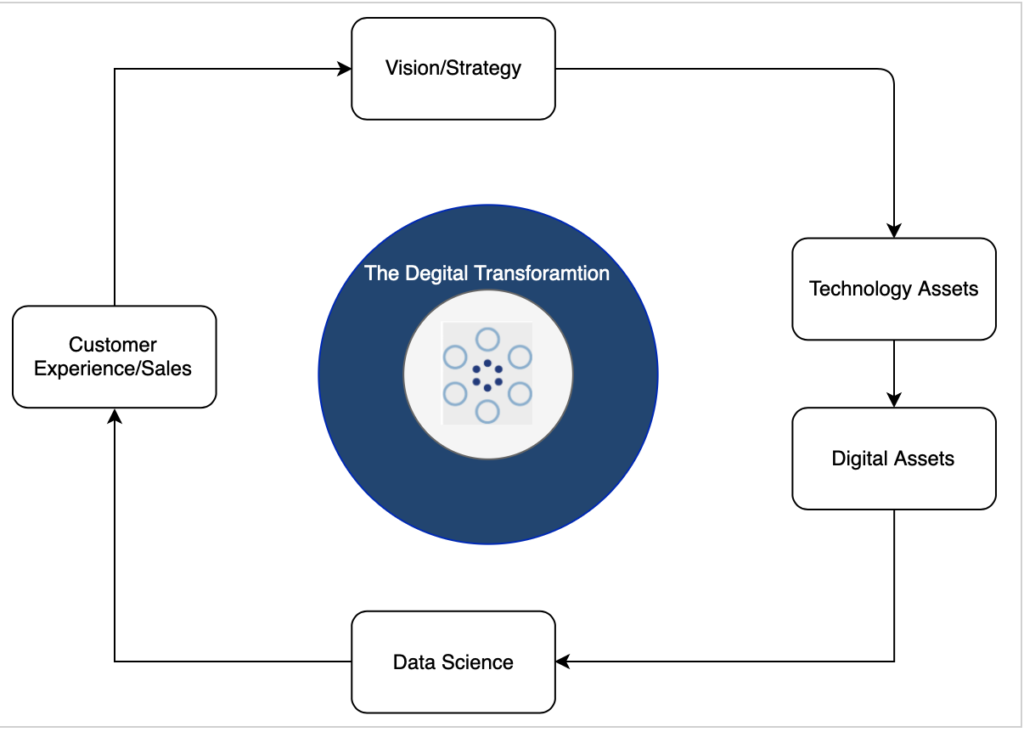Digital Transformation is a strategy to operationalize business innovation using digital technologies into your operational process, products, solutions, and customer interactions in order to create and monetize business assets that include both digital and non-digital. Digitizing non-digital assets is one of the core strategy of the Digital Transformation.
One of the Digital transformation strategy is to build an ecosystem that coherently and seamlessly integrate customers, partners, employees, suppliers, and external entities. Such integration allows the organization to a integrated view of data. Such integrated data provides an opportunity to create contextual intelligence to drive business value.
Data and digitization are at the heart of digital transformation. The out of of the transformation must be:
- Data is easily, quickly, and reliably accessible
- Data collection, delivery, and analytical model execution happens in real-time without any human intervention
- Data must be secured
The Digital Transformation strategy enable business to transform and innovate the business at speed without having to worry that due to inflexibility of operations and applications degrades customer experience to new business strategy. The Digital Transformation enables organization to be nimble and agile; because as a part of transformation, we build a digital platform by standardizing and creating consistent architecture and design on both business process and technology assets.

There are four major parts to the digital journey – Vision & Strategy, Assets (Technology and Talent), Data Science and Customer Experience (Sales -> Revenue).
Vision & Strategy – It is old age saying that know where you are going. This is modern time GPS to guide and focus our journey into the correct headings and preferably correct path. There may be detours and re-direction at times; however, Vision & Strategy shall guide us to our destination that is achieve our end goals.
Assets – A company’s biggest holdings are its assets – either technology and talents or real estates. The assets in particular technology and talents, are the focus of the transformation. During the digital journey, we are enhancing talents through policing existing and acquiring new if necessary. However, we are revamping technology to bring greater value to our customers. A technology refresh does not mean that we get latest gadgets and toys. The goal is that any investment in technology must directly impact the customer experiences; hence, the bottomline. Any technology asset must enable the organization to achieve greater customer experiences that is our ability to monetize our digital assets.
Data Science – Our third pillar is our ability to make sense using our assets technology and talents. The organization should be able to use new or old techniques and methods to analyze and learn from the data. Once, we found models that best answers our questions, we use technology to achieve automation in analyzing and learning using those models. This is a continuous process that is learn → re-tool → discover → learn. Data Science is definitely the major focus; however, there are many steps before we can get to it. For example, there is data identification and integration that are fundamental steps before data science. Thus, this part of journey embodies technological changes – development and implementation; to achieve our customer experience.
Customer Experience – Our drive for digital transformation is to achieve Customer Experience that is increase revenue. Our vision and strategy must align with the Customer Experience. It may be up-selling to existing customers or acquiring new customers that the organization is missing due to not having complete picture of the business. The most important one is to be able to identify and execute on new business opportunities quickly. Therefore, Customer Experience shall drive the business and digital transformation.

To achieve Digital transformation, an organization must have a leadership vision that is incorporated into the strategy to steer both organizational and technology directions. There may be less of organization change than adopting new technological assets. The end goal of the vision shall be to digitize the assets and then monetize based on those assets.



